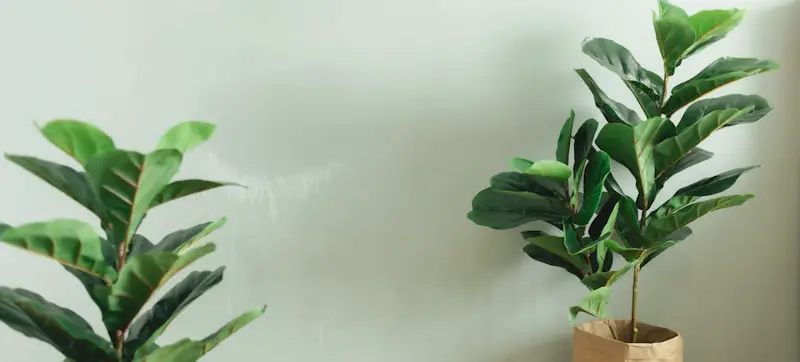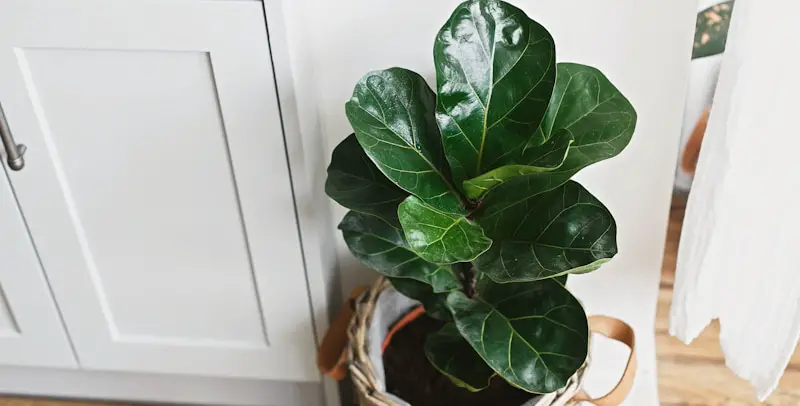When preparing to repot a fiddle leaf fig tree, you could be intimidated by the enormity of the root ball or the plant’s seeming fragility. Many people would tell you how replanting a fiddle leaf fig is complicated or tough, but in reality, it is simple to accomplish and poses little risk to your plant.
To repot a fiddle leaf fig, mix your new soil in a new container, then remove the plant from the pot. Carefully remove as much old soil as possible without damaging the plant root. Now fill the planter with the new soil and place the root ball into the pot. Fill it up and water it.
Replanting a fiddle leaf fig should be done during the growing season, spring or summer. This is because they dislike change, so any repotting or other adjustments you make will make it much more difficult for the plant to recover.

How To Repot A Large Fiddle Leaf Fig
You should only repot a plant after observing roots encircling the pot’s outside edge, masses of roots visible on the surface, or roots protruding from the pot’s bottom. Holding onto the plant’s base or trunk, you can confirm this by carefully wiggling and removing the plant from the pot.
The plant should come out of the pot pretty easily, and you can count the roots you can see to determine whether or not they are root-bound. The most crucial step in repotting your fiddle, regardless of whether it is root bound or needs new soil, is eliminating as much old soil as possible and blowing out any bound roots.
Simply putting your Fiddle Leaf in a larger pot and adding dirt to the sides will not work if it is root-bound. This is due to the roots’ training to encircle the pot; they must be fluffed out to develop normally once more. Additionally, adding new soil to the periphery will reduce the effectiveness of your irrigation.
When watering a pot with two different soil types, the water will follow the shortest route to the pot’s bottom. Add dirt to your new container to create a surface for the root bulb to rest. Though the base of the soil must be significantly lower than the top of the jar, ensure your root ball will not sit too high when it is in place. If the earth is laying too low, add extra.
The next step is to take the root ball out of the pot that is already there. Avoid damaging the roots at all costs. If the root ball becomes trapped, you might want to use scissors to cut down the container’s side. Before you repot your plant, you are not advised to water it because this might make the root ball prone to breaking.
Put fistfuls of soil outside the base of a tree while holding it upright to cover the edges of the pot encircling the root ball. Once your container is full, carefully compress the soil all over the root ball. Avoid over-compaction because your plant requires space for its roots to expand.
Give your plant plenty of water, filling the pot to ensure that any significant air bubbles are covered with dirt. If the margins of the soil are less than the middle, you may have to add more dirt at this point. You are set after you have hydrated the tree, and the topsoil is evenly distributed all across the top of the jar.
How To Repot A Fiddle Leaf Fig With Root Rot
Root rot is among the issues that fiddle leaf fig growers frequently deal with. When the soil around a plant’s roots is constantly wet, microorganisms in the soil cause the roots to rot and die. If not detected in time, the rot will extend from the root to the entire plant and eventually destroy it.
You must replant your fiddle leaf fig as soon as you are certain that it does indeed have root rot. The plant must first be taken out of its existing pot. Gently pull it out in a way to avoid damaging the roots. To more readily examine the roots, wash or remove as much of the previous soil as possible. White and strong to the touch, good roots will be white.
You must remove any decaying roots from the plant before repotting it if any of the roots are black or brown and seem mushy to the touch. Cut out the impacted roots using a sterile pair of scissors or a knife. Ensure no decaying roots are left to prevent the plant from becoming infected again.
After removing all the diseased roots and foliage, you are prepared to repot the plant. Pick a fresh clay or terracotta pot with bottom drainage holes that are the right size. The old soil must all be disposed of because it is polluted. You can reuse the old pot; however, ensure you fully wash and sanitize it first to eliminate all bacteria.
You will have to modify your soil mix if the root rot and excessive watering result from poorly draining soil. Use one that has perlite or gritty sand to help the soil drain more effectively. These substances, which are larger and firmer than soil particles, will provide more fluid movement of air and water around the plant’s roots.
After putting the plants inside the new pot, fill it with fresh soil. Avoid compacting the soil by not packing it in. Just let it be free and open. Water the plant right after repotting it so it can begin healing.

What Size Pot For Fiddle Leaf Fig
Due to their capacity to raise the amount of contrast in your apartment’s interior design, fiddle leaf figs are primarily known as domestic plants. They grow swiftly, are also simple to maintain, and you may choose a unique container size for them. On the other hand, a fiddle leaf’s pot size can be unclear; as a result, we have identified every pot size that a fiddle leaf might require.
Your fiddle leaf fig should continue to be planted in pots that are 3 to 5 inches wide and 1 to 2 inches higher than the pot it was first placed in. Most essential, avoid using containers with a diameter greater than 7 inches since, in extra-large containers, plant roots may rot.
As a general rule, ensure the container is at least 3 times as large as it was to allow for sufficient drainage. The plant is likely to suffer if the pot is not triple times the initial size. The pot should also be cleaned, along with any debris. You should be careful when selecting the right pot for fiddle leaf fig plants.
Due to their fragility, these plants should receive as much assistance as needed while growing. They frequently have root rot, and the pot you select needs good drainage and a robust support foundation. They dislike being crowded, so pick a pot with two to three tiny drainage holes separated by about an inch.
The container should comfortably fit four to six leaves. Last but not least, make sure to give space for development when selecting a container for your fiddle leaf fig plant. Use a broad, medium-sized pot with a light, sturdy base.
Also read: Root Rot In Fiddle Leaf Fig – What It Is & How To Treat It
Final Thoughts
The huge, lush leaves of fiddle leaf figs make them Instagram-famous plants because they enhance the appearance of any indoor environment. You must repot your fiddle leaf fig immediately if it develops root rot. Pull the plant from its previous container, wash out the dirt, cut off any rotting roots, and then plant it in a fresh container with enough drainage holes and soil that drains properly. To help the plant recuperate after being repotted, water it.
Similar post:
- Fiddle Leaf Fig Outdoors – Can They Survive? [GUIDE]
- Are Fiddle Leaf Figs Toxic to Dogs & Cats? [ANSWERED]
- How To Propagate Wandering Jew? [GUIDE]
Victoria is the owner and main author of hobby plants. She loves spending her free time in her garden planting and taking care of her plants. Victoria hopes you enjoy the content here!
![Fiddle Leaf Fig Outdoors - Can They Survive? [ANSWERED] Fiddle Leaf Fig Outdoors - Can They Survive? [ANSWERED]](https://www.hobbyplants.com/wp-content/uploads/2022/07/fiddle-leaf-fig-outdoors-300x158.jpg)

![Are Fiddle Leaf Figs Toxic to Dogs & Cats? [ANSWERED] Are Fiddle Leaf Figs Toxic to Dogs & Cats? [ANSWERED]](https://www.hobbyplants.com/wp-content/uploads/2022/07/are-fiddle-leaf-figs-toxic-to-dogs-300x158.jpg)
![How to Repot A Snake Plant? [STEP BY STEP GUIDE] How to Repot A Snake Plant? [STEP BY STEP GUIDE]](https://www.hobbyplants.com/wp-content/uploads/2022/08/how-to-repot-snake-plant-300x158.jpg)
![How To Propagate Wandering Jew? [COMPLETE BEGINNER'S GUIDE] How To Propagate Wandering Jew? [COMPLETE BEGINNER'S GUIDE]](https://www.hobbyplants.com/wp-content/uploads/2022/07/how-to-propagate-wandering-jew-300x158.jpg)
![How To Propagate Pothos? [COMPLETE BEGINNER'S GUIDE] How To Propagate Pothos? [COMPLETE BEGINNER'S GUIDE]](https://www.hobbyplants.com/wp-content/uploads/2022/07/how-to-propagate-pothos-300x158.jpg)
![Mother Of Thousands Plant [Complete Plant Care Guide] Mother Of Thousands Plant [Complete Plant Care Guide]](https://www.hobbyplants.com/wp-content/uploads/2022/07/mother-of-thousands-plant-300x158.jpg)
![How Often Should You Water Pothos? [Complete Care Guide] How Often Should You Water Pothos? [Complete Care Guide]](https://www.hobbyplants.com/wp-content/uploads/2022/07/how-often-to-water-pothos-300x158.jpg)
![Bleeding Heart Plant Varieties [COMPLETE BEGINNER'S GUIDE] Bleeding Heart Plant Varieties [COMPLETE BEGINNER'S GUIDE]](https://www.hobbyplants.com/wp-content/uploads/2022/07/bleeding-heart-plant-300x158.jpg)
![Can Snake Plants Live Outside? [COMPLETE CARE GUIDE] Can Snake Plants Live Outside? [COMPLETE CARE GUIDE]](https://www.hobbyplants.com/wp-content/uploads/2022/08/can-snake-plants-live-outside-300x158.jpg)
![Majesty Palm Plant Care: [Complete Beginner's Guide] Majesty Palm Plant Care: [Complete Beginner's Guide]](https://www.hobbyplants.com/wp-content/uploads/2022/08/majesty-palm-care-300x158.jpg)
![Exotic Angel Plant Care: [Complete Beginner's Guide] Exotic Angel Plant Care: [Complete Beginner's Guide]](https://www.hobbyplants.com/wp-content/uploads/2022/08/exotic-angel-plant-care-300x158.jpg)